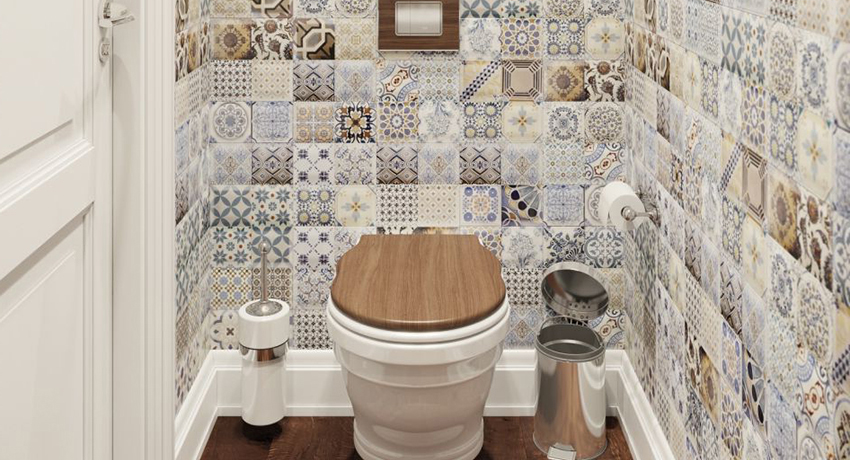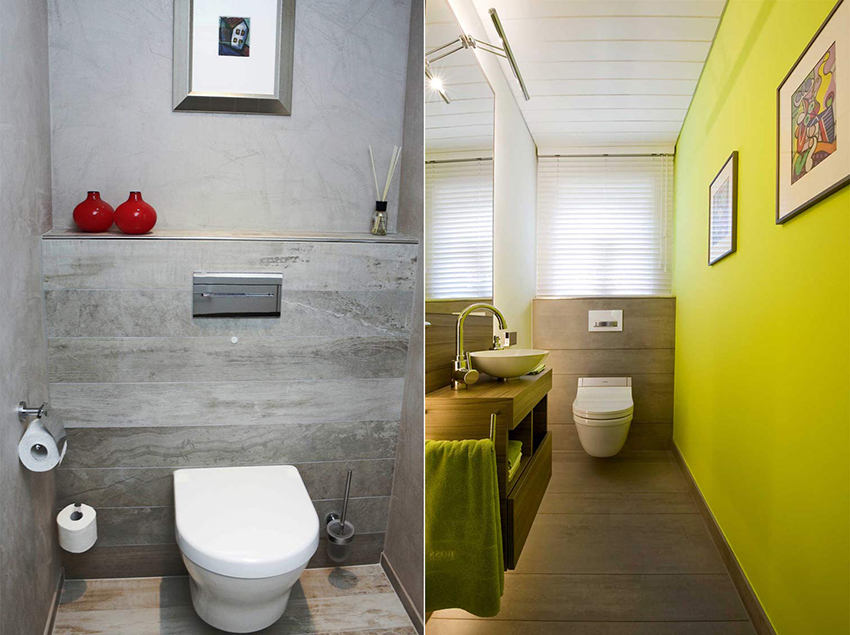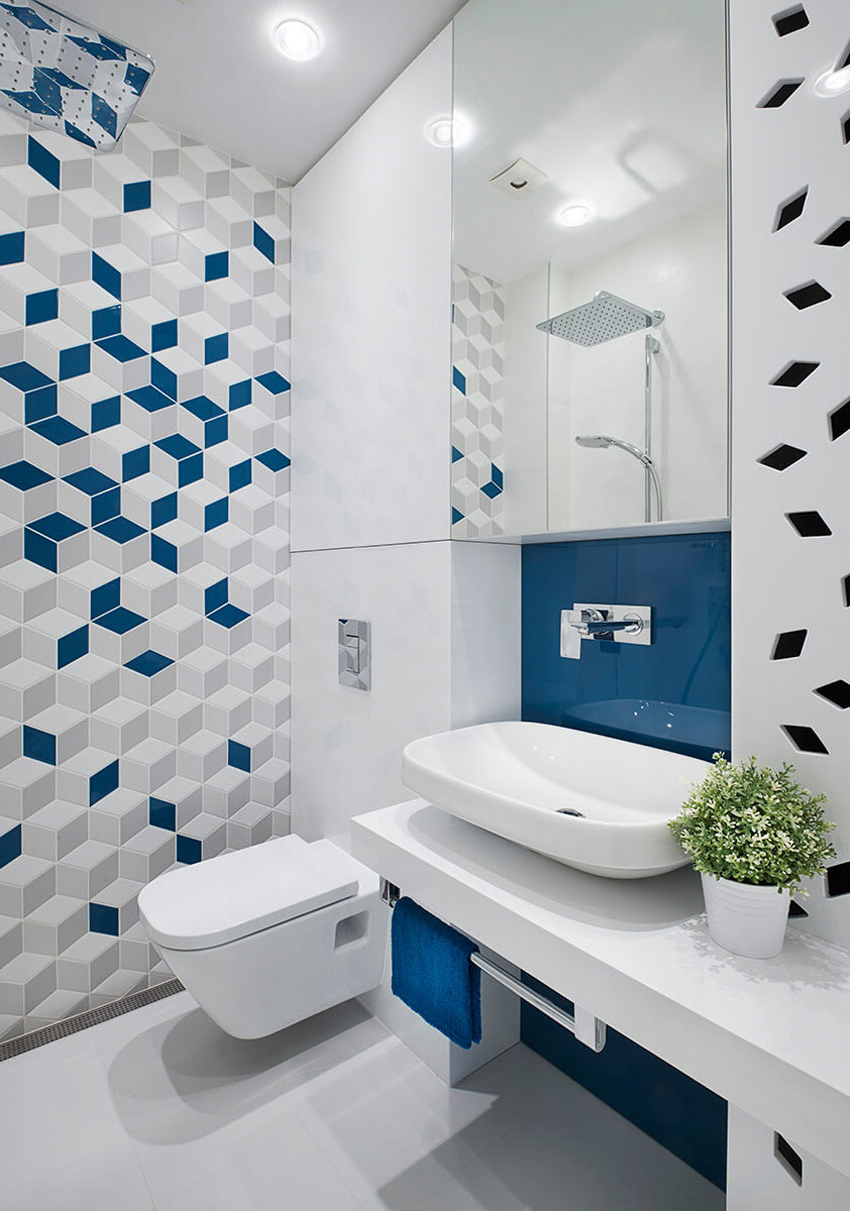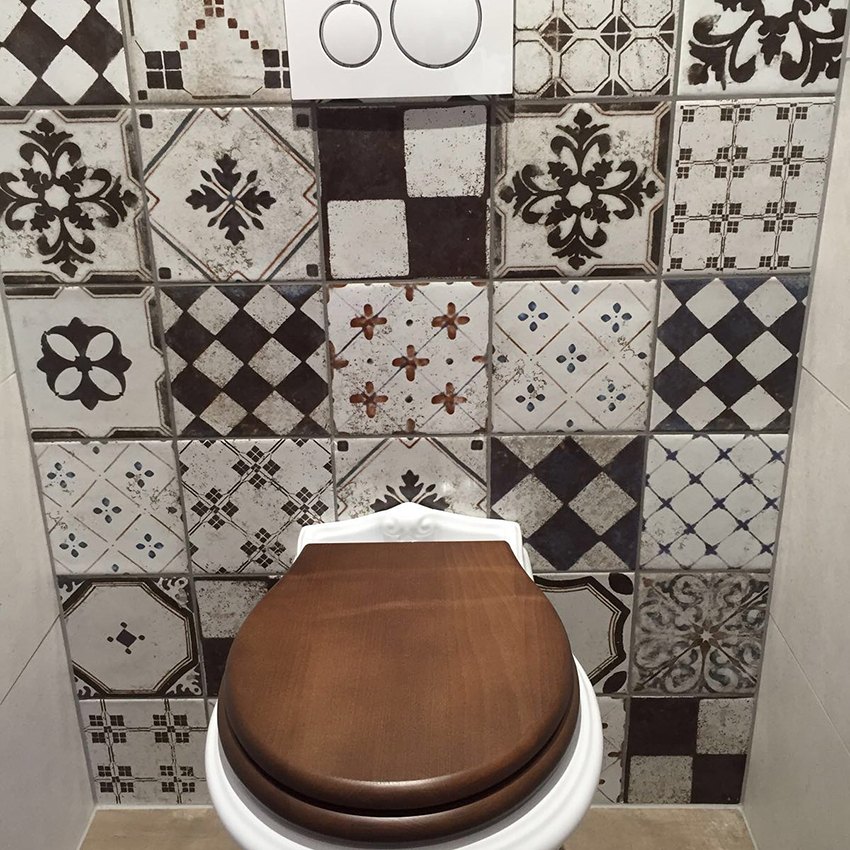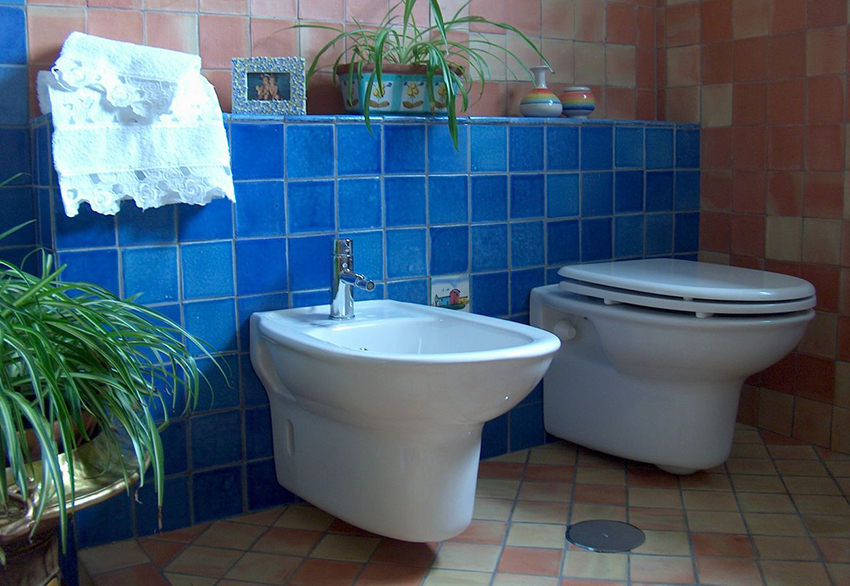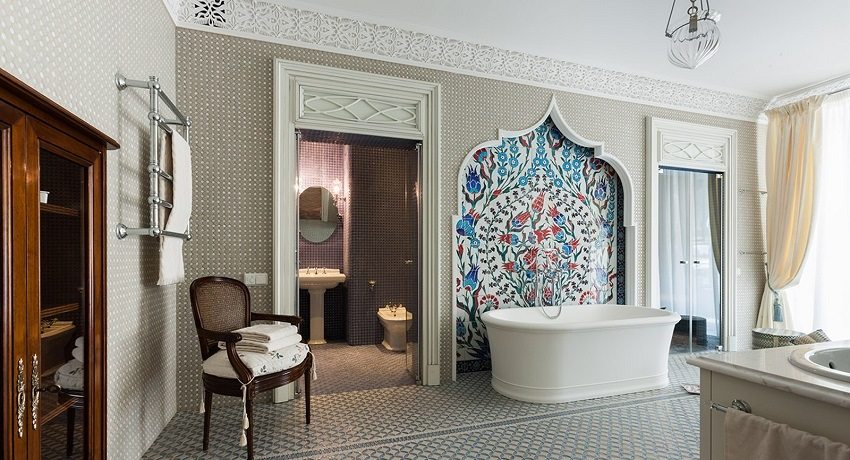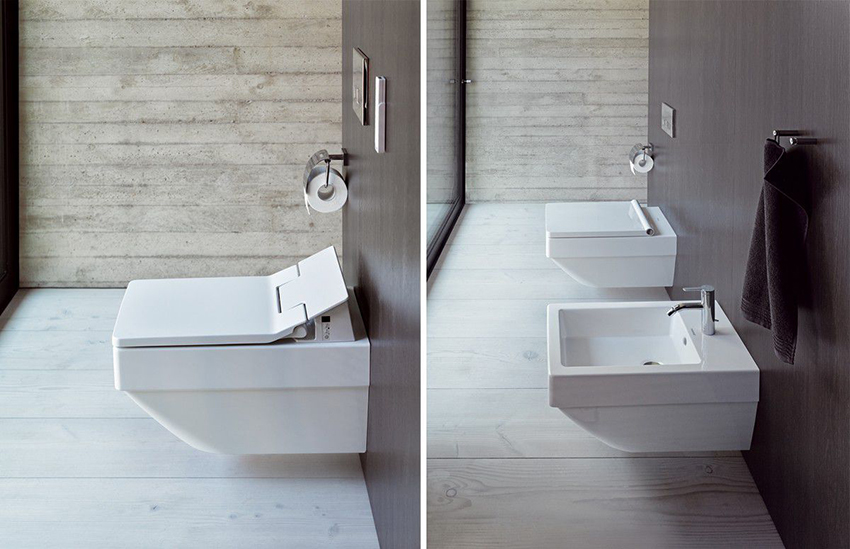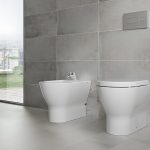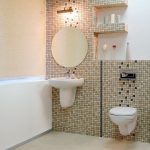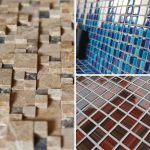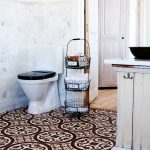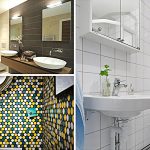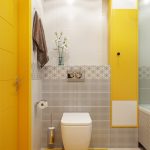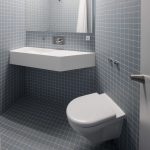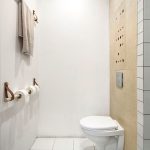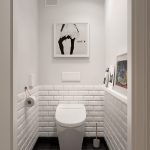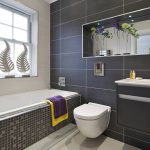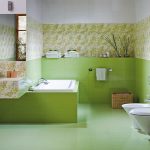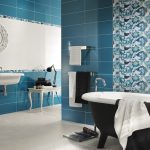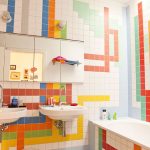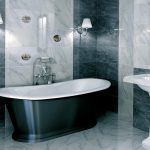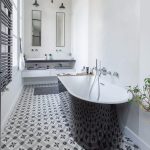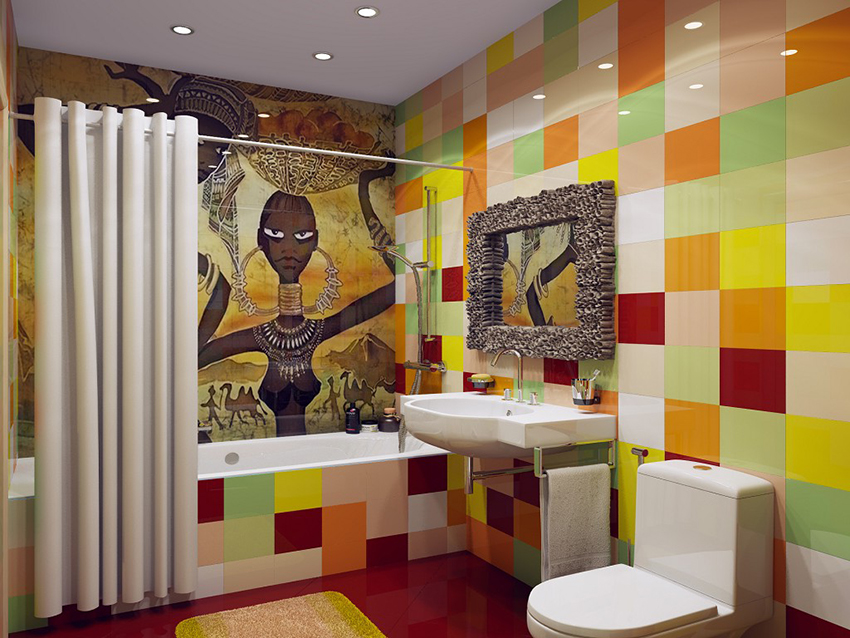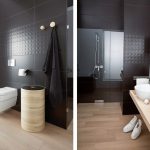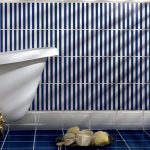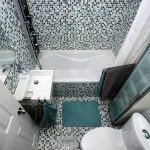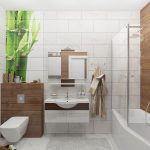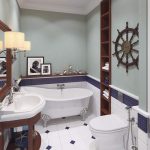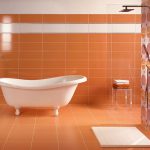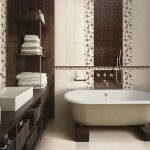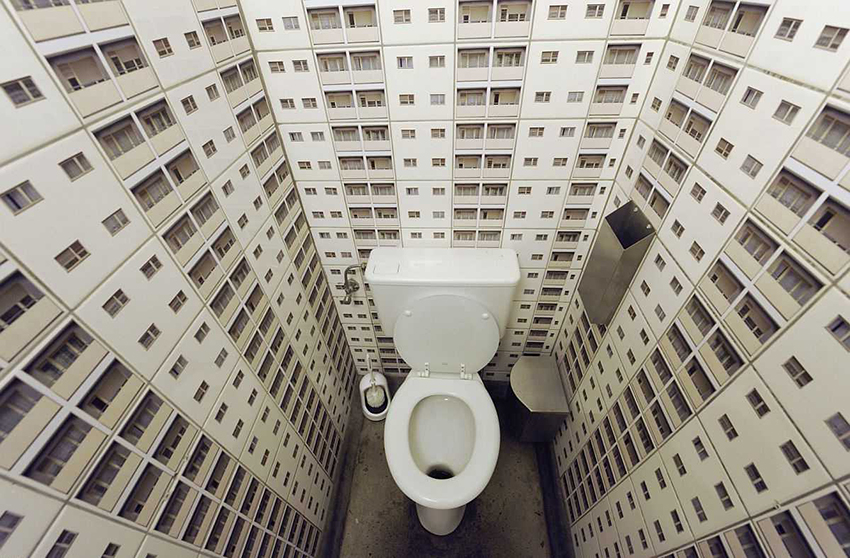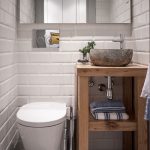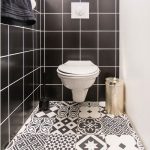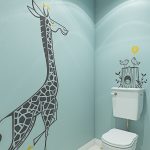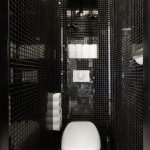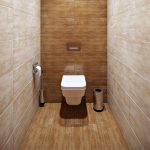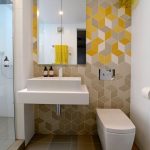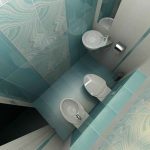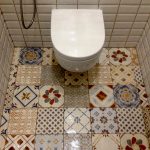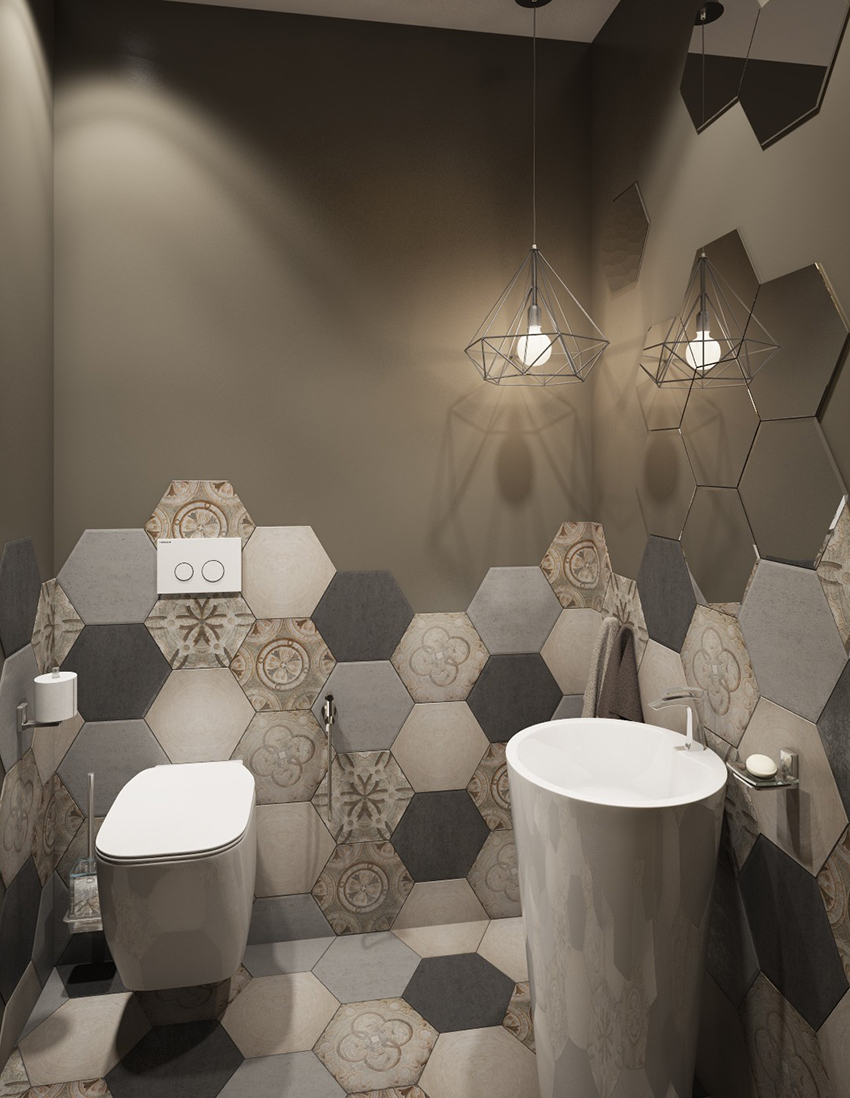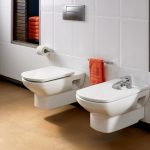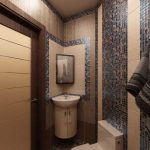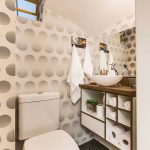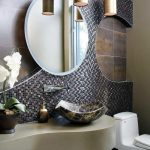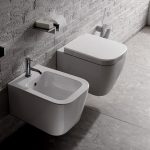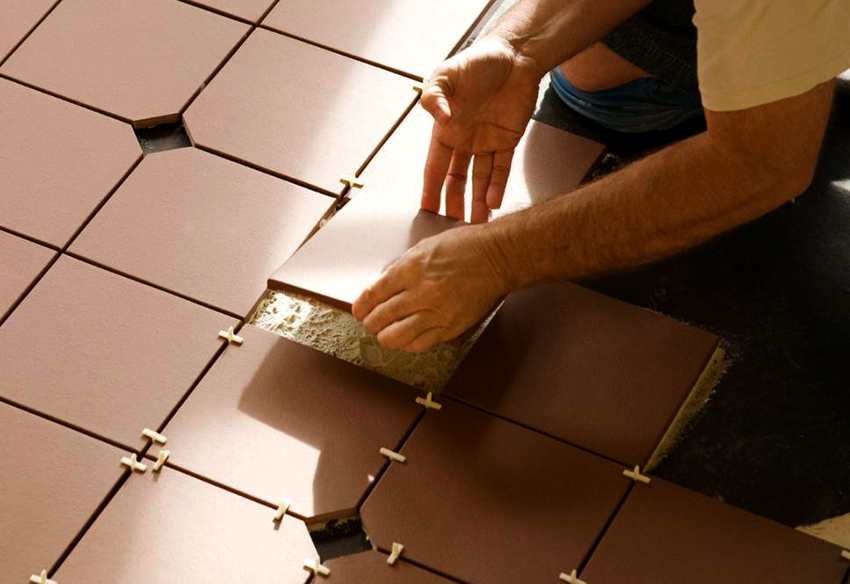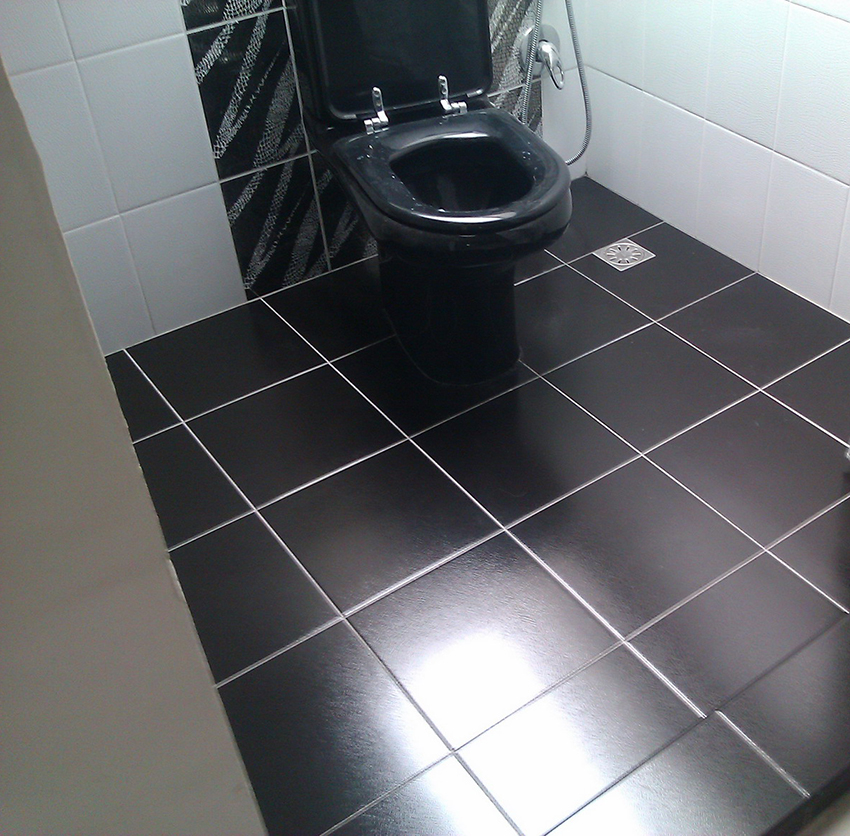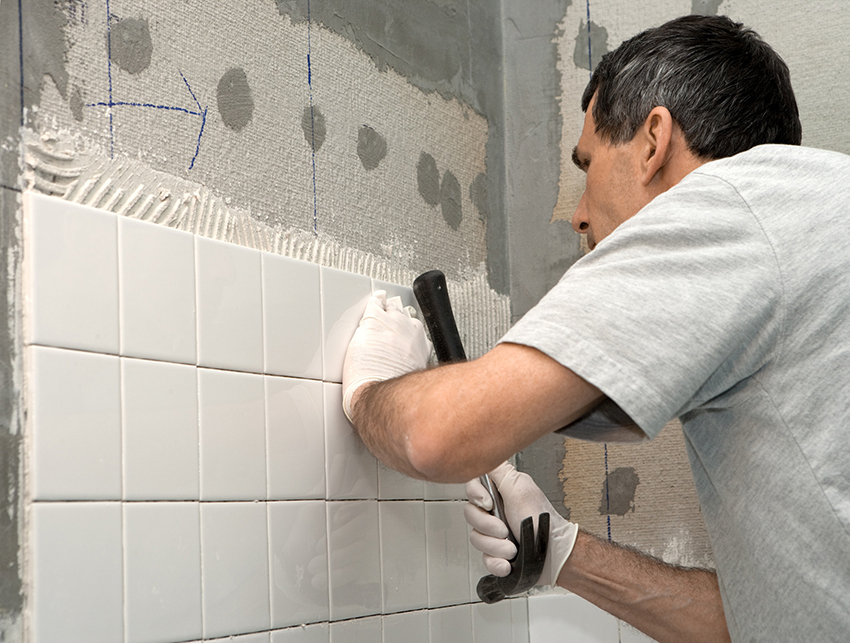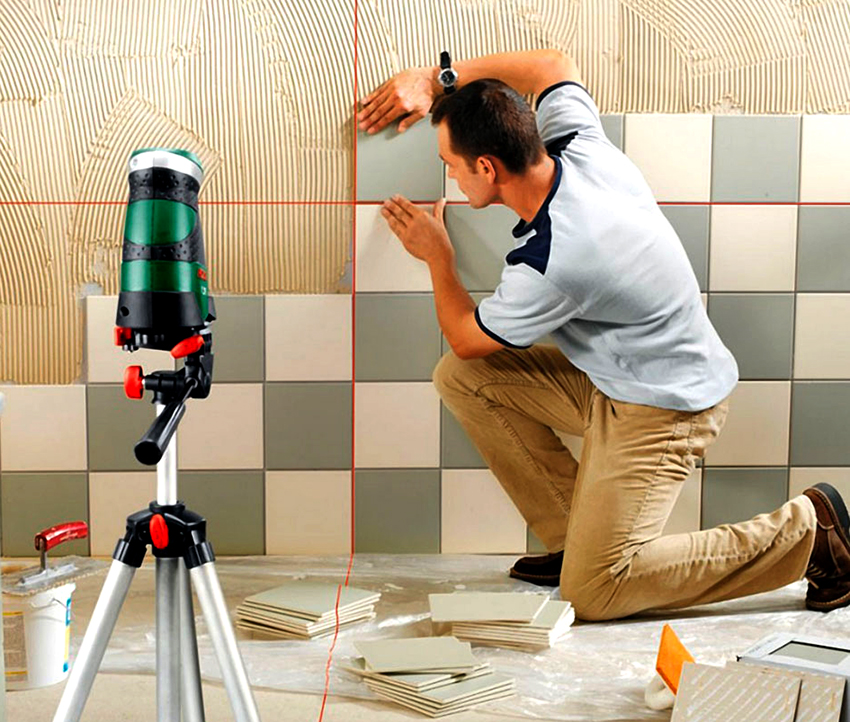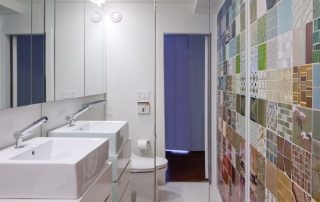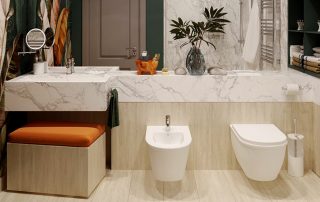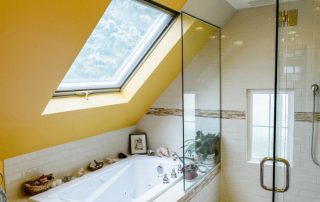Toilet tile is a common cladding material that is practical, strong and durable. Rooms with high humidity require hygienic cleanliness, so it is difficult to find a more suitable option than tiles. This article will discuss the main varieties of this material and tips for choosing and styling it.
Content [Hide]
- 1 Advantages and disadvantages of ceramic tiles for a bathroom
- 2 Varieties of ceramic tiles for the toilet
- 3 What does the marking of ceramic tiles mean?
- 4 How to choose bathroom and toilet tiles: tips
- 5 Sizes and shapes of tiles in the toilet: photos of standard and unusual products
- 6 Laying tiles in the toilet with your own hands: preparing a bathroom
Advantages and disadvantages of ceramic tiles for a bathroom
Tile as a facing material has many advantages. Its popularity is primarily due to its technical characteristics. It is also worth noting that it does not require special care, as dust and dirt do not linger on it. In order to clean the surface covered with ceramic tiles, it is enough to use a regular damp cloth or sponge and any detergent.
Another advantage of toilet tiles is their high environmental friendliness. It does not emit harmful chemical compounds and does not cause allergic reactions even in sensitive people. Ceramic is also a fire retardant cladding material that is resistant to mold and mildew.
Helpful information! The operational life of the tile is more than a dozen years. The strength of this material allows you to place household appliances on it, as well as furniture elements.
The use of ceramic cladding also has some drawbacks that you need to pay attention to before buying it. One of the main downsides is the cold surface. However, this disadvantage can be eliminated by laying the tiles on top of the warm floor.
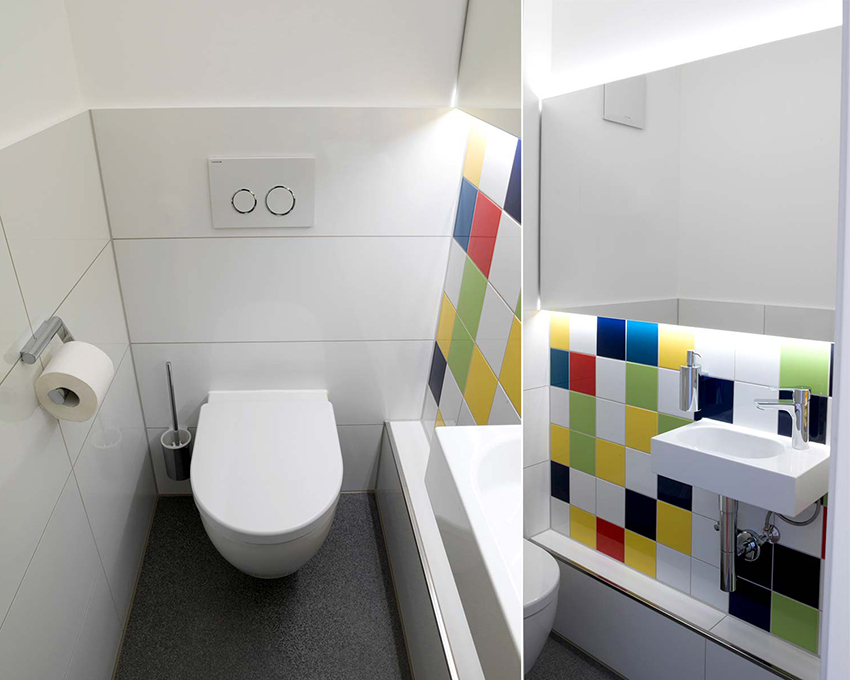
In addition to the advantages, the tile also has some disadvantages that are worth paying attention to.
The tile does not have a good sound insulation coefficient. However, if desired, you can additionally lay materials on the floor and walls that will absorb sound. For the installation of the tile itself, it is advisable to have construction skills and knowledge.Laying is done only on a perfectly flat surface.
It is recommended to calculate the number of tiles and choose its design in advance, before installation. This will avoid trouble during installation. Experts also recommend that you study the photo of the tile used for lining the bathroom. This will allow you to visually assess the relevance of various design solutions.
Varieties of ceramic tiles for the toilet
This material is mainly used for wall and floor cladding in bathrooms and toilets. Products of this kind are classified not only in composition, but also in size, shape, and quality characteristics. Consider the most common types of facing tiles.
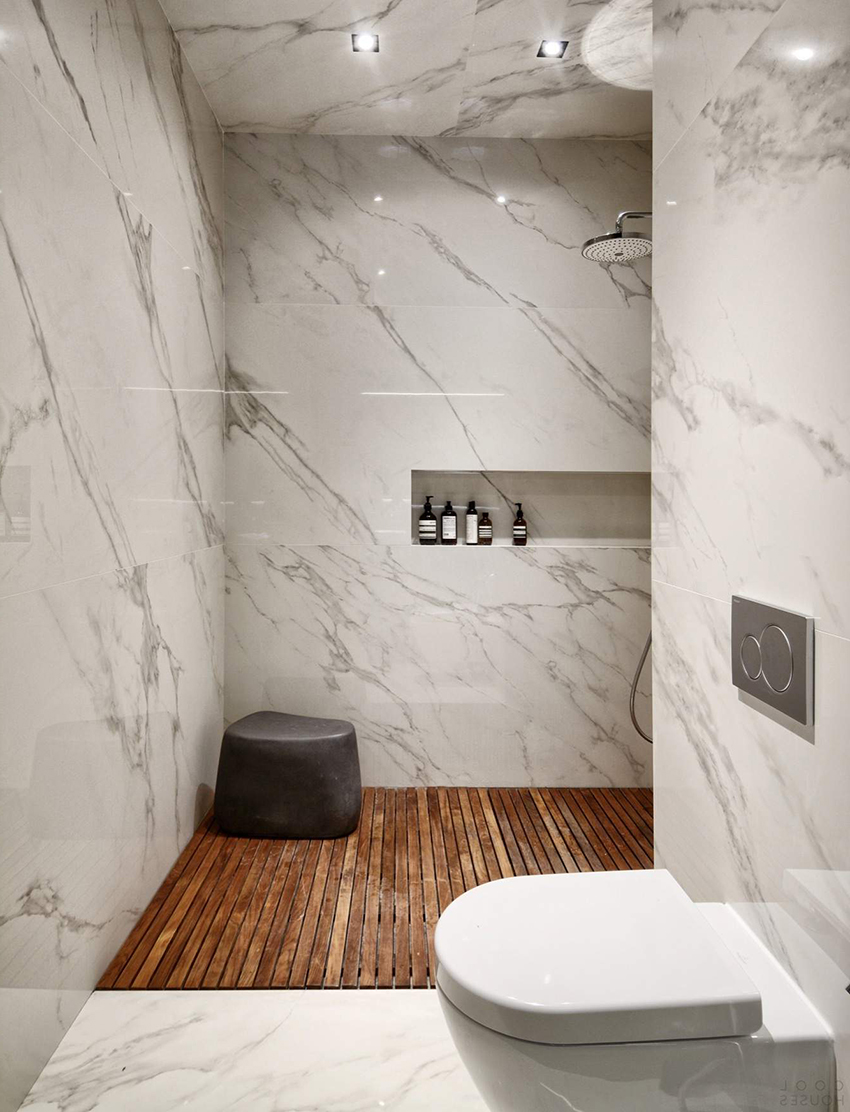
Before installation, it is necessary to determine the design and make an accurate calculation of the number of tiles
Tile with a picture. This is one of the most popular solutions for decorating a bathroom. A more common option is plain colored cladding. It is used both for complete styling and for decorating individual interior elements.
In a combined bathroom, using such a tile, you can select a mirror or plumbing. Patterned tiles are often used in combination with conventional colored ceramics. This solution is a fairly popular tile design in small toilets. Photos of products that differ in color and pattern can be viewed online.
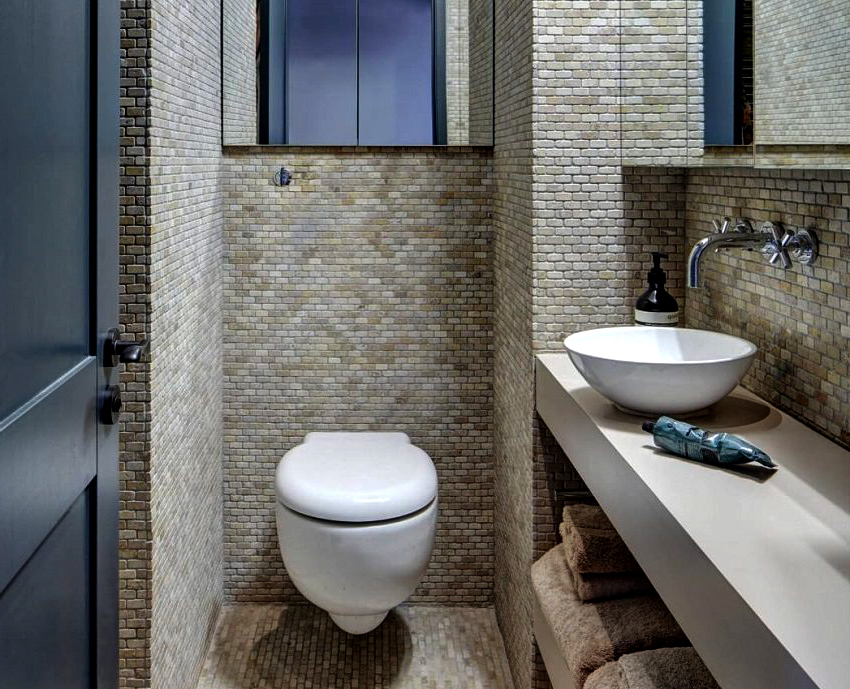
Ceramic tiles are very diverse, they differ not only in size and shape, but also in their characteristics
Textured tiles. This type of cladding is original. On the construction market, you can find many options for textures, as well as colors of such ceramics. Tiles imitating natural stone, wood, etc. are very popular.
The cost of textured cladding is higher than for conventional products, but the result justifies the price. Such tiles are laid according to the same principle as in the case of standard ceramics.
Mosaic. This type of ceramic lining is small in size. This factor allows mosaic tiles to be laid on surfaces that are not perfectly flat. It is used for facing arches, curved, asymmetrical and convex elements.
Note! Thanks to mosaic tiles, it becomes possible to create complex ornaments that can decorate any interior. In terms of design, this cladding material is the most interesting.
On sale you can find piece and block mosaics. The second is sold as a full-fledged toilet tile and is suitable for installation only on perfectly flat surfaces.
Porcelain stoneware. This material is highly durable and is often used in public washrooms. The durability of porcelain stoneware determines its purpose. As a rule, it is laid on the floor. The dimensions of the tiles made of this material are slightly larger compared to conventional products. This simplifies its installation.
Related article:
Ceramic tiles in the bathroom: design of modern finishes
Advantages and disadvantages of the material, design of products from catalogs and photos of finishing in the interior of the room, prices for products.
Toilet wall and floor tiles
All ceramic tiles used for toilet or bathroom cladding are divided into two types: wall and floor. The first one is not as strong and is also lighter in weight.Another property that such a cladding should have is the equipment of an anti-slip coating. It is not recommended to lay the tiles for the floor on the walls, as it may simply not stay on the vertical surface.
Today the range of wall tiles is incredibly wide. It differs in size, color and texture. On the construction market, you can purchase products with a glossy or matte surface, with a pattern, textured, as well as mirror tiles... Photos of tiled elements will allow you to visually evaluate how it will look in the interior of a small toilet or a combined bathroom.
In turn, floor tiles are classified into several types depending on the manufacturing method. Let's consider them in more detail:
- pressed;
- extruded;
- porcelain stoneware.
For home styling, the first two varieties are best suited. However, if desired, you can also use porcelain stoneware cladding, which is characterized by high strength. You can buy toilet tiles in any specialized store or hypermarket, and there is also the possibility of placing an order via the Internet.
What does the marking of ceramic tiles mean?
The tile, which is produced by European brands, is divided into three types, depending on the quality of performance. You can determine the type of tile by the color of the marking. Products marked in red are of the highest quality. Many experts recommend buying them, as they are most suitable for bathrooms and toilets. Medium quality products are traditionally marked in blue, and low quality products are traditionally marked in green.
It is also worth paying attention to another indicator of bathroom and toilet tiles - resistance to chemical compounds. In the marking, it is indicated using Latin letters, such as:
- AA (high resistance);
- B (medium resistance);
- C (low resistance).
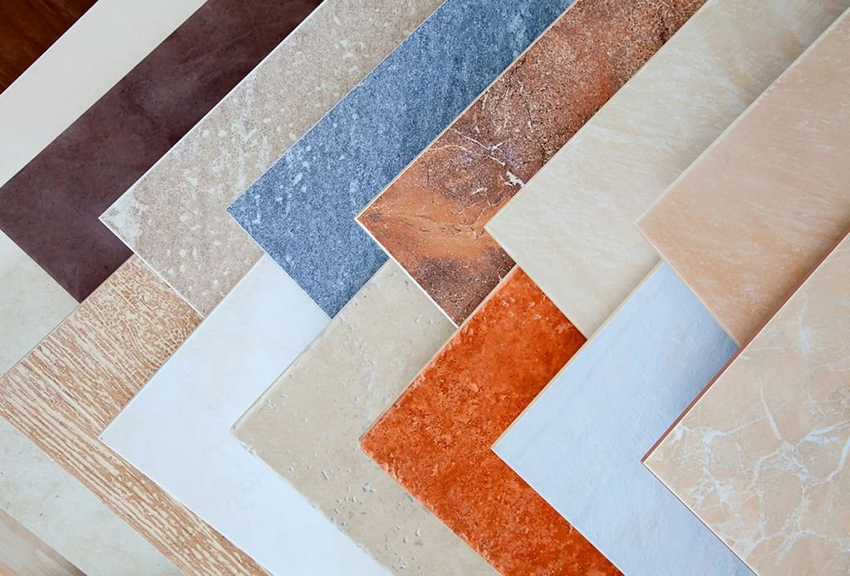
Tile quality is divided into three types, the highest quality is marked in red, medium quality in blue, and low quality in green
Note! Roman numerals on a tile indicate its resistance to wear and tear. For laying at home, it is most advisable to use a tile that has a Ι-wear resistance class.
How to determine the purpose of the tile? To understand for what purposes the tile is used, you need to pay attention to the icon indicated on it. It can be a foot (floor tile) or a brush (wall tile).
How to choose bathroom and toilet tiles: tips
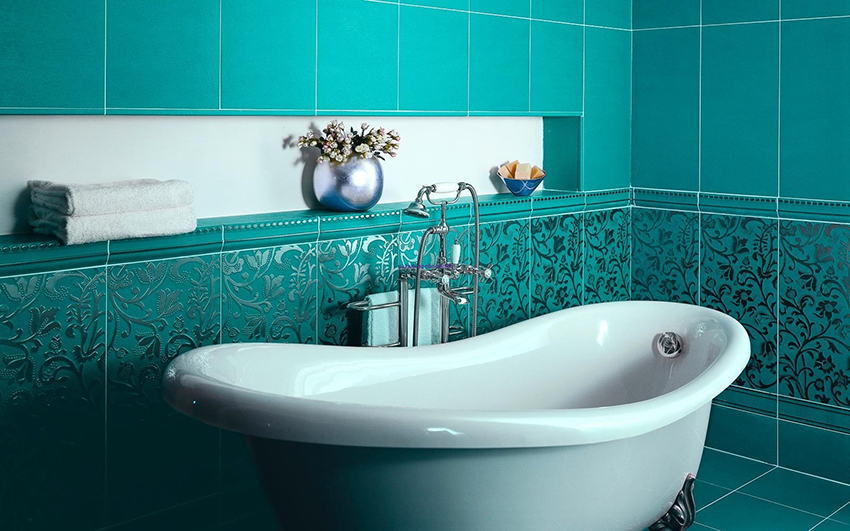
For small rooms, it is better to choose tiles of light colors so that the room seems visually larger
In order to answer the question of how to choose tiles for the bathroom and toilet, it is necessary to pay attention to several important factors. First of all, it is necessary to take into account the size of a particular room. For example, for small rooms, it is advisable to select tiles of light colors, since it visually expands the space. The dark design of the walls and floor of a bathroom or toilet, on the contrary, visually narrows the area of the room.
Before laying the tiles in the toilet, it is recommended to draw up a laying diagram. For this, it is very important to determine in advance the location of all plumbing fixtures in the room, as well as additional interior elements.
The surface on which the tile will be laid is also one of the determining factors when buying it. So, for the floor, matte or embossed tiles with good resistance to mechanical stress are best suited. However, such a tile requires more careful maintenance. This is due to the fact that it is more susceptible to pollution.Glossy, lightweight tiles are best for walls.
Tiles from Italian brands are of the best quality. Such products have a long service life, but they also cost more than their domestic counterparts.
Further, the choice of facing material is carried out depending on the design of the room and the personal preferences of the owners. Before buying a tile, you should also decide in advance on its quantity and study the dimensions of ceramic tiles. Photos of these products, both before and after installation, allow you to assess the appropriateness of a particular style.
Toilet design: selection of tiles depending on color
As mentioned above, light tiles are best suited for small spaces. Designers recommend choosing light tiles that have a muted tone to visually expand the area. If desired, you can finish the toilet with tiles of different colors. In this case, the rule is that light-colored facing materials increase the area. The combination of several light shades will not damage the space of the toilet or bathroom.
On the other hand, dark tiles have a narrowing, muffling effect. If you decide in any case to use tiles of dark colors, then it is recommended to lay it on the ceiling. Thus, the effect of lengthening the room is achieved. This tile is also suitable for laying on the floor, but it is better to choose another option for wall decoration.
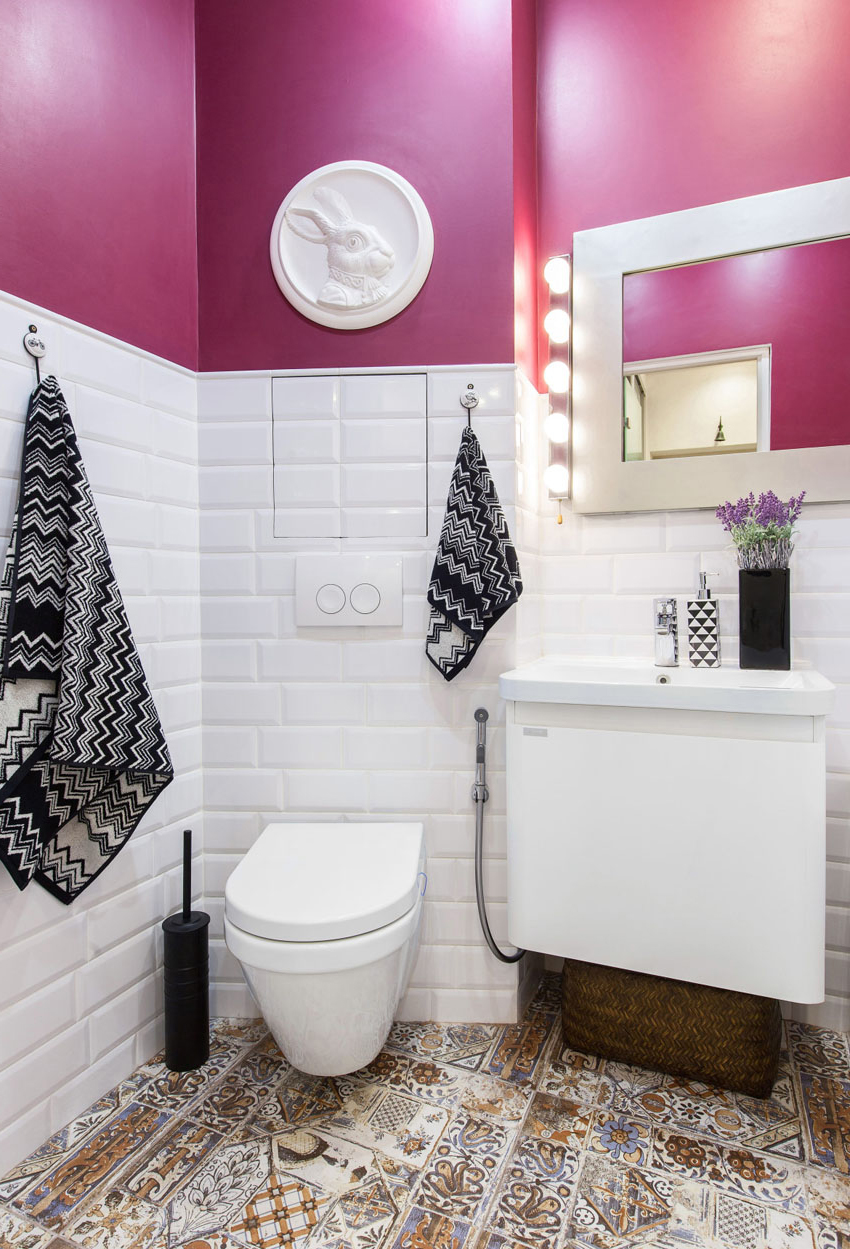
To create a bright design, it is better to use no more than four colors that will be combined with each other.
Helpful information! If you want to combine several colors, then you need to remember that you should not choose too many shades for this. 2-4 colors are enough for a combination.
The tile can have an ornament and a picture. For a toilet, such a tile is not the best solution. However, if you want to smooth out corners in a room, then patterned tiles will let you do just that.
Thanks to the variety of toilet tile designs, you can correctly place accents both in a small and in a larger room. And also it becomes possible to assemble a certain pattern from individual tiled elements.
Toilet design 2 sq. m (without bathroom): photos and recommendations
Small toilets in panel houses have a small area (only 2 square meters). Decorating such a small space in a unique style is not an easy task. Limited space does not allow installation of unique, stylish plumbing fixtures. Also, in such a restroom it is rather difficult to place additional interior items (for example, shelves).
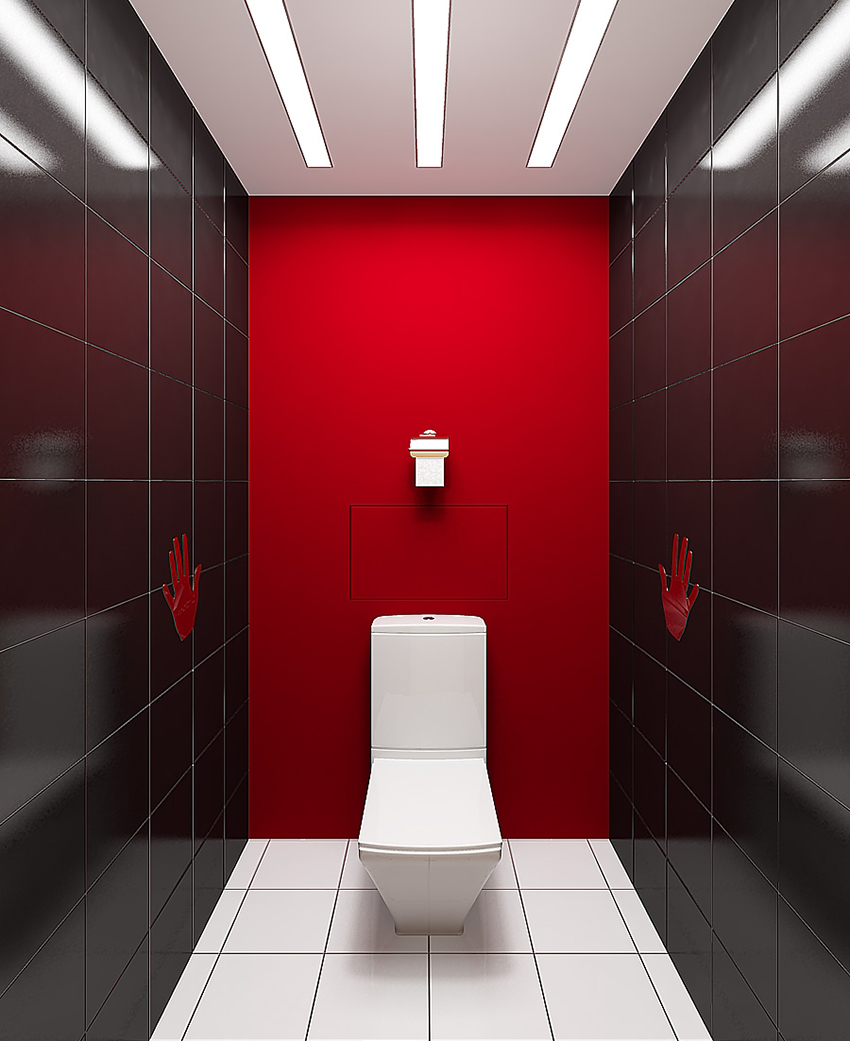
It is not recommended to use dark tiles for finishing the walls of small rooms; it is better to put it only on the floor or ceiling
To decorate a toilet in a panel house, you can use tiles of two or more colors. The basis of the room's design is the back wall. It is best for her to choose tiles of the same size. It is recommended to define the primary and secondary colors in advance. The first should occupy the main area of the wall, and the second is used as an accent and is usually laid in one strip. Photos of toilets after tile repair will help you decide on the choice of stylistic direction.
To visually expand the space of a small-sized toilet, the back wall can be completely dark. In this case, the side walls should be light, and best of all, white. Thus, there is a visual lengthening of the room.
You can also use the tile for the toilet, which has an ornament. This will create coziness in a small room. The drawings on the tiles can be monochrome and multi-colored, as well as mirrored. It is also recommended to place them on the back wall.Any of these options can be used for a bathroom in a panel house.
Sizes and shapes of tiles in the toilet: photos of standard and unusual products
The modern construction market is distinguished by a variety of facing materials. The range of ceramic tiles is incredibly wide. First of all, it is recommended to pay attention to the shape of these products, which can be:

The choice of tiles is very wide, it can be not only of different sizes, but also of different shapes
- square;
- rectangular;
- triangular;
- diamond-shaped.
Square tiles are the classic floor tiles. The standard dimensions of such a tile are 30x30 and 50x50 cm. Rectangular products are most often used for wall decoration. As for their size, it is usually 25x20 cm.
The choice of tiles with a complex shape depends entirely on the individual characteristics of the toilet. Photos of the tiles (before and after installation) will help you decide on the choice of the necessary cladding.
Note! Designers advise using small tiles when the room does not have sufficient dimensions. Large tiles are suitable for a spacious room and will reduce the number of seams.
An excellent and modern solution is a multifunctional tile collection. Such facing material has a single color or pattern and a different texture. These kits are used for laying on the floor in all areas of an apartment or house, keeping in mind the same concept. A variety of textures allows you to choose the necessary tiles for the toilet, kitchen, living room and other rooms.
It is recommended to look at the corresponding photos. The tiles in the toilet in a modern style have a presentable appearance and effectively cope with their functions.
Laying tiles in the toilet with your own hands: preparing a bathroom
Before laying tiles, preparatory work must be done. First of all, you need to prepare the floor. This is explained quite simply: the main pipes pass through it, which deliver water to the apartment. The presence of plumbing in the toilet is the main reason for the high humidity coefficient. Therefore, the facing surfaces must be equipped with a waterproofing material.
If the walls were previously painted with oil paint or whitewash, then before laying the tiles in the toilet, it is imperative to completely remove the layers of these substances. This rule must be observed in any case, otherwise the facing material will not have the necessary adhesion to the wall.
To remove paint and whitewash from work surfaces, you will need to prepare a spatula and a water tank in advance. The next step is to apply a primer to the walls and floor. The composition will provide good adhesion of the tile to the finishing surfaces.
How to lay the tiles in the toilet on the floor: instructions
It is very important to remember that self-laying tiles requires certain skills or very precise adherence to the work algorithm. Any deviation from the instructions can turn into problems during the installation of ceramic tiles. Some of them are very difficult to solve, and hardly anyone wants to redo the work.
First, you need to purchase all the necessary tools and materials that will be required for this process. Let's consider them in more detail:
- tile;
- spatula (notched);
- glue or cement mortar;
- crosses;
- building level.
Note! If all products are of the same color, then you can start styling. When the installation of alternating, multi-colored tiles is required, the best solution would be to draw up a preliminary drawing.A paper stacking diagram will help you avoid mistakes while working.
So how to lay the tiles in the toilet with your own hands? It is best to start the installation of ceramic cladding from the far (from the entrance) corner of the room. The solution on which the tile will "sit" is carried out in accordance with the instructions. After making it, you need to take a notched trowel and apply the composition to the floor surface. It should be enough for laying 2-3 facing products.
Then the first tile is laid. It is important to remember that there should be a gap of several millimeters between the wall and the edge of the product. The required distance is achieved by means of crosses made of plastic. Each product must be checked at the building level without fail. Alignment is performed both horizontally and vertically.
After laying the first tile, it is necessary to put crosses that contribute to the observance of even seams, and continue installation. This technology is followed throughout the entire process of laying tiles on the floor. Photos will help you understand the intricacies of this process. And it is also recommended to watch a few training videos that you can easily find on the net.
As a rule, in the corners and at the wall located near the door, it is necessary to cut the facing material. For this purpose, a special device is used - a tile cutter. An ordinary grinder can also replace it, but it does not guarantee the required accuracy. This is how the toilet tiles are repaired. The photo, which shows the stages of installation and the final result, will help you independently understand the technology.
After laying the tiles, you need to wait about a day. During this time, the cement slurry will have time to dry. At the final stage, grouting is carried out with a spatula and a dry cloth.
How to lay tiles in the toilet on the wall: work algorithm
For installation on the wall in the toilet, you can choose a traditional tile, which has a rectangular shape. Inserts with patterns are also in great demand, giving the room individuality. Mosaics in small bathrooms look very impressive, but they take longer to install.
Let's consider step by step how to lay the tiles in the toilet on the walls. Before installing the cladding, the masters recommend that you mark the walls. To do this, you can use a regular marker or pencil. The markings allow you to arrange the rows evenly. At the level of the second of them, it is necessary to install a support rail.
Then you need to apply cement mortar or adhesive to the wall. It is important to remember that if the wall is not perfectly flat or even has significant protrusions, then this problem has a solution. You just need to apply more mortar, which will fill the wall defects and level the tiles. Experts recommend to study the photo of the toilet with tiles before installation.
Note! When laying tiles on the wall, you must also use the building level and plastic crosses. Installation of cladding material starts from the bottom, but the first row is placed last.
The first tile should be placed in the corner near the wall farthest from the door. Then the installation and alignment of the following elements of the row is carried out, as well as the addition of cut fragments. The box, which is installed in toilets to hide the sewer pipe, is also tiled with tiles.
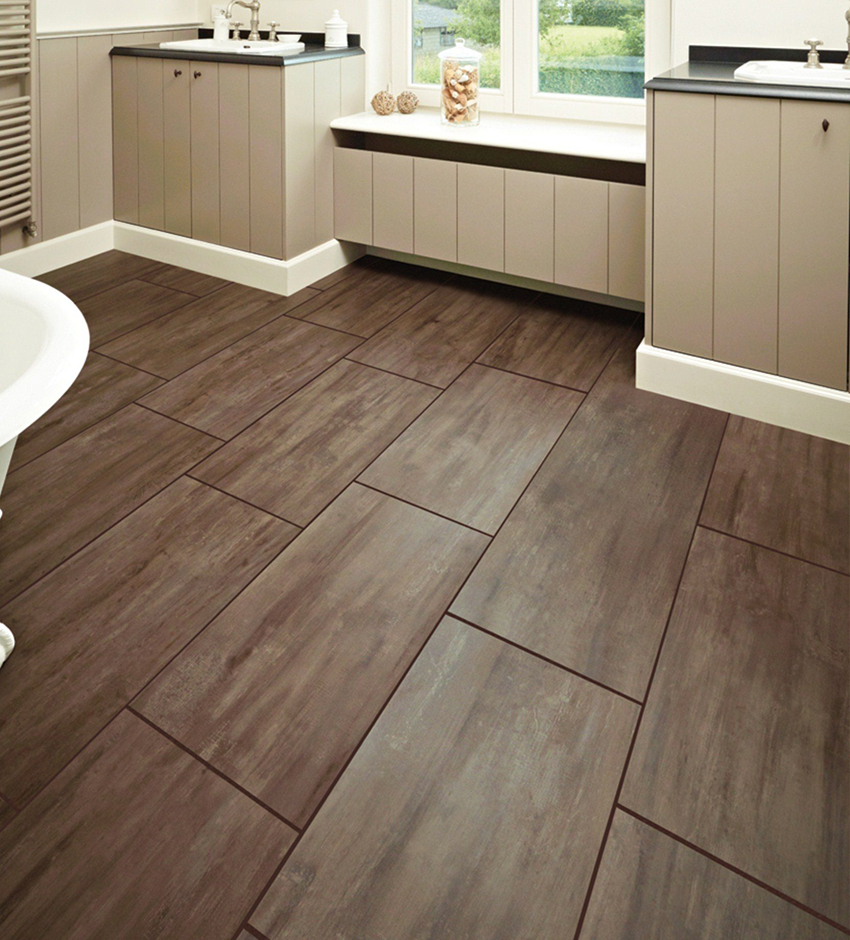
Laying tiles in toilet on your own will save money, the main thing is to do everything correctly and not to rush
Knowing the answer to the question of how to lay tiles in the toilet, you can complete the whole process yourself and save your finances. Masters do not recommend rushing during the installation of tiles. The best solution in this case is to work in short sets.
Thus, toilet tiles are an excellent solution that will protect the walls in a damp room from fungus. The choice of tiles depends on the size of the restroom, as well as the individual preferences of the owners. Self-styling requires care and precision.
